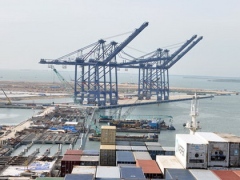Vung Tau seaports receive few vessels despite huge investments
>> Cai Mep port welcomes one of world’s biggest container ships
>> Puny service charges leaves port short
>> Cai Mep International Terminal inaugurated
This grim reality runs counter to the investors’ high expectations of developing Ba Ria – Vung Tau into an urban port with high container-loading capacity.
Ports have been built in large quantities, but the infrastructure serving their operations remains undeveloped, experts said.
According to the Vietnam Port Association (VPA), the total container-handling capacity of the ports in Ba Ria – Vung Tau is as much as 8 million twenty-foot equivalent unit (TEU), while the real demand is no more than 5 million TEU.
In spite of the surplus capacity, the province is set to welcome several new ports in 2012, and 2013, VPA said.
According to the provincial Department of Transport, Ba Ria – Vung Tau is now home to 53 seaports, 23 of which are already operational, while those remaining will soon reach completion.
The department also said the total registered investment in the seaport system in the province by the end of last year was more than $7 billion, while disbursement was worth $2 billion.
Few vessels come to the ports
In contrast to the high density of deep-water seaports in the area, and the busy atmosphere at the construction sites of the new ports, a gloomy air can be found at the ports most of the time.
On the road leading to the two major deep-water ports, Tan Cang – Cai Mep and CMIT, there are hardly any container trucks loading cargo in and out the ports. There are no vessels loading or unloading goods at the ports’ cranes, either.
While the container ports in Ho Chi Minh City are always packed with cargo ships and piles of containers, those in Cai Mep – Thi Vai only have several containers scattered around.
The container loading machines in the ports have also constantly been left unused, with ships coming to the ports for loading only two or three days a week, a man working for a deep-water port in Cai Mep – Thi Vai said.
The director of a container seaport said the fact that ports do not have many containers to handle not only reduced the ports’ attractiveness to shipping companies, but also forced them to cut fees to appeal to vessels, which would understandably result in losses.
Inadequate logistics development
Industry insiders said another reason for the unattractiveness of the ports is that the traffic system and logistics services supporting the ports have been underdeveloped.
National route No 51, the main road connecting the Cai Mep – Thi Vai area with the main traffic system, has deteriorated, with its surface full of cracks and potholes.
Meanwhile, route no 956 connecting national route 51 and other major seaports has yet to be completed. Even worse, the project to build roads linking the ports is still no more than a blueprint.
“This is because we have failed to finish the site clearance and compensation tasks due to a capital shortage,” Luong Anh Tuan, deputy director of the provincial Department of Transport, explained.
Since the road traffic infrastructure is incomplete, ship owners now have to use barges to transport their containers to the ports, according to VPA.
“This means of transportation is ineffective as it increases the transporting fee for the container owners,” said VPA general secretary Ho Kim Lan.
“Ba Ria – Vung Tau has only completed construction on the seaports, but totally neglected the completion of road traffic and logistics services.”
What the stars mean:
★ Poor ★ ★ Promising ★★★ Good ★★★★ Very good ★★★★★ Exceptional
Related Contents
Latest News
More News
- Global partnerships key to Vietnam’s IFC development (December 26, 2025 | 16:18)
- Vingroup pulls out of bid to invest in North-South high-speed railway (December 26, 2025 | 11:42)
- Strengthening supply chains through trade promotions and customs reform (December 24, 2025 | 14:00)
- PM orders investment model for North–South high-speed rail (December 22, 2025 | 17:43)
- LS Eco Energy to invest in Vietnam rare earth sector (December 22, 2025 | 17:31)
- Government moves to establish International Financial Centre (December 21, 2025 | 21:00)
- Vietnam's IFC to target global investment flows (December 21, 2025 | 18:00)
- Two national hospitals expand capacity with new facilities (December 20, 2025 | 09:00)
- Ha Tinh breaks ground on major Vingroup industrial and energy projects (December 19, 2025 | 18:24)
- EVN launches major power infrastructure projects nationwide (December 19, 2025 | 18:17)


 Tag:
Tag:





















 Mobile Version
Mobile Version